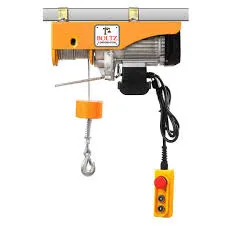


Chain Block and Lever Hoist Essential Tools for Lifting
In industrial and construction settings, the ability to lift and move heavy objects safely and efficiently is paramount. Two of the most commonly used tools for this purpose are the chain block and the lever hoist. These devices, while seemingly simple in design, are built upon principles of mechanical advantage, making them invaluable for various lifting applications.
Chain Block An Overview
A chain block, also known as a chain hoist, operates using a simple yet effective gear mechanism that allows for the lifting of heavy loads with minimal effort. The core component of a chain block is a steel chain, which is looped over a pulley attached to a lifting hook. When the user pulls down on the free end of the chain, the internal gearing mechanism reduces the effort needed to lift the load. This multiplication of force allows a person to lift hundreds of kilograms with a relatively low amount of physical strength.
Chain blocks are designed for vertical lifting and are typically suspended from a secure overhead structure, such as a beam or a hoist frame. Their versatility makes them suitable for use in warehouses, garages, manufacturing plants, and construction sites. Different models of chain blocks have varying load capacities, ranging from a few hundred kilograms to several tons, depending on the specific application.
Lever Hoist A Different Approach
In contrast to the chain block, the lever hoist utilizes a ratchet and pawl mechanism for lifting and moving loads. The lever hoist, often referred to as a lever block, consists of a lever arm that the operator pulls down to lift the load attached to the hook. Similar to the chain block, the lever hoist also provides mechanical advantage, allowing the user to lift heavy objects with less effort.

Lever hoists are particularly favored in scenarios where space is limited or when immediate load adjustment is required, as the lever arm can be operated in tight quarters. The portability of lever hoists makes them an excellent choice for construction sites, rigging applications, and maintenance work where heavy loads need to be repositioned. With capacities usually ranging between 0.5 tons to 9 tons, they are invaluable tools for both professional and DIY applications.
Safety Features and Considerations
When using either a chain block or a lever hoist, safety should always be a top priority. Both devices come equipped with essential safety features, such as overload protection, which prevents lifting beyond the rated capacity. It is crucial to perform regular inspections and maintenance to ensure these tools remain in good condition.
Proper training in the use of these lifting devices is equally important. Operators should be aware of safe lifting techniques, the importance of securing loads properly, and the proper use of protective gear to minimize risks associated with lifting operations.
Conclusion
Chain blocks and lever hoists are critical tools in the arsenal of anyone involved in lifting and moving heavy loads. Their design, based on simple mechanical principles, offers practicality and efficiency. Understanding the differences between these two devices — the chain block’s vertical lifting capabilities and the lever hoist’s adaptability in tight spaces — allows users to choose the right tool for their specific needs. Emphasizing safety, maintenance, and proper operation ensures that these essential lifting devices can be leveraged to facilitate safe and effective handling of heavy materials across various industries. These tools not only enhance productivity but also contribute to a safer working environment, making them fundamental in construction and industrial settings.



